Somatotype and Bioimpedance Vector Analysis: A New Target Zone for Male Athletes
Abstract
1. Introduction
2. Materials and Methods
2.1. Subjects
2.2. Procedures
2.3. Statistical Analysis
3. Results
- Endomorphic mesomorph: mesomorphy was dominant and endomorphy was greater than ectomorphy (more than 0.5 units).
- Balanced mesomorph: mesomorphy was dominant, and endomorphy and ectomorphy were similar (no difference or <0.5 units).
- Ectomorphic mesomorph: mesomorphy was dominant and ectomorphy was greater than endomorphy (more than 0.5 units).
- Mesomorph ectomorph: endomorphy and ectomorphy were similar (no difference or <0.5 units).
- Mesomorphic ectomorph: ectomorphy was dominant and mesomorphy was greater than endomorphy (more than 0.5 units).
- Balanced ectomorphy: ectomorphy was dominant, and endomorphy and ectomorphy were similar (no difference or <0.5 units).
4. Discussion
5. Conclusions
Author Contributions
Funding
Acknowledgments
Conflicts of Interest
References
- Campa, F.; Semprini, G.; Júdice, P.B.; Messina, G.; Toselli, S. Anthropometry, physical and movement features, and repeated-sprint ability in soccer players. Int. J. Sports Med. 2019, 40, 100–109. [Google Scholar] [CrossRef]
- Toselli, S.; Campa, F. Anthropometry and functional movement patterns in elite male volleyball players of diferent competitive levels. J. Strength Cond. Res. 2018, 32, 2601–2611. [Google Scholar] [CrossRef] [PubMed]
- Carter, J.E.L.; Heath, B.H. Somatotyping Development and Applications; Cambridge University Press: Cambridge, UK, 1990. [Google Scholar]
- Carter, J.E.; Phillips, W.H. Structural changes in exercising middle-aged males during a 2-year period. J. Appl. Physiol. 1969, 27, 787–794. [Google Scholar] [CrossRef] [PubMed]
- Choudhary, S.; Singh, S.; Singh, I.; Varte, L.R.; Sahani, R.; Rawat, S. Somatotypes of Indian Athletes of Different Sports. Online J Health Allied Sci. 2019, 18, 6. [Google Scholar]
- Gualdi, R.E.; Graziani, I. Anthropometric somatotype of Italian sport participants. J. Sports Med. Phys. Fit. 1993, 33, 282–291. [Google Scholar] [PubMed]
- Raković, A.; Savanović, V.; Stanković, D.; Pavlović, R.; Simeonov, A.; Petković, E. Analysis of the elite athletes’ somatotypes. Acta Kinesiol. 2015, 9, 47–53. [Google Scholar]
- Sánchez Muñoz, C.; Muros, J.J.; López Belmonte, Ó.; Zabala, M. Anthropometric characteristics, body composition and somatotype of elite male young runners. Int. J. Environ. Res. Public Health 2020, 17, 674. [Google Scholar] [CrossRef]
- Sánchez-Muñoz, C.; Zabala, M.; Williams, K. Anthropometric variables and its usage to characterise elite youth athletes. In Handbook of Anthropometry; Preedy, V., Ed.; Springer: New York, NY, USA, 2012; ISBN 978-1-4419-1787-4. [Google Scholar]
- Castizo-Olier, J.; Irurtia, A.; Jemni, M.; Carrasco-Marginet, M.; Fernández-García, R.; Rodríguez, F.A. Bioelectrical impedance vector analysis (BIVA) in sport and exercise: Systematic review and future perspectives. PLoS ONE 2018, 13, e0197957. [Google Scholar] [CrossRef]
- Campa, F.; Matias, C.N.; Marini, E.; Heymsfield, S.B.; Toselli, S.; Sardinha, L.B.; Silva, A.M. Identifying athlete body-fluid changes during a competitive season with bioelectrical impedance vector analysis. Int. J. Sports Physiol. Perform. 2020, 15, 361–367. [Google Scholar] [CrossRef]
- Campa, F.; Silva, A.M.; Toselli, S. Changes in phase angle and handgrip strength induced by suspension training in older women. Int. J. Sports Med. 2018, 39, 442–449. [Google Scholar] [CrossRef]
- Souza, M.F.; Tomeleri, C.M.; Ribeiro, A.S.; Schoenfeld, B.J.; Silva, A.M.; Sardinha, L.B.; Cyrino, E.S. Effect of resistance training on phase angle in older women: A randomized controlled trial. Scand. J. Med. Sci. Sports 2017, 27, 1308–1316. [Google Scholar] [CrossRef] [PubMed]
- Toselli, S.; Badicu, G.; Bragonzoni, L.; Spiga, F.; Mazzuca, P.; Campa, F. Comparison of the effect of different resistance training frequencies on phase angle and handgrip strength in obese women: A randomized controlled trial. Int. J. Environ. Res. Public Health 2020, 17, 1163. [Google Scholar] [CrossRef] [PubMed]
- Marini, E.; Campa, F.; Buffa, R.; Stagi, S.; Matias, C.N.; Toselli, S.; Sardinha, L.B.; Silva, A.M. Phase angle and bioelectrical impedance vector analysis in the evaluation of body composition in athletes. Clin. Nutr. 2020, 39, 447–454. [Google Scholar] [CrossRef]
- Francisco, R.; Matias, C.N.; Santos, D.A.; Campa, F.; Minderico, C.S.; Rocha, P.; Heymsfield, S.B.; Lukaski, H.; Sardinha, L.B.; Silva, A.M. The predictive role of raw bioelectrical impedance parameters in water compartments and fluid distribution assessed by dilution techniques in athletes. Int. J. Environ. Res. Public Health 2020, 17, 759. [Google Scholar] [CrossRef] [PubMed]
- Piccoli, A.; Rossi, B.; Pillon, L.; Bucciante, G. A new method for monitoring body fluid variation by bioimpedance analysis: The RXc graph. Kidney Int. 1994, 46, 534–539. [Google Scholar] [CrossRef] [PubMed]
- Piccoli, A.; Nigrelli, S.; Caberlotto, A.; Bottazzo, S.; Rossi, B.; Pillon, L.; Maggiore, Q. Bivariate normal values of the bioelectrical impedance vector in adult and elderly populations. Am. J. Clin. Nutr. 1995, 61, 269–270. [Google Scholar] [CrossRef] [PubMed]
- Piccoli, A.; Pillon, L.; Dumler, F. Impedance vector distribution by sex, race, body mass index, and age in the United States: Standard reference intervals as bivariate Z scores. Nutrition 2002, 18, 153–167. [Google Scholar] [CrossRef]
- Rösler, A.; Lehmann, F.; Krause, T.; Wirth, R.; Von Renteln-Kruse, W. Nutritional and hydration status in elderly subjects: Clinical rating versus bioimpedance analysis. Arch. Gerontol. Geriatr. 2010, 50, e81–e85. [Google Scholar] [CrossRef]
- Bronhara, B.; Piccoli, A.; Pereira, J.C.R. Fuzzy linguistic model for bioelectrical impedance vector analysis. Clin. Nutr. 2012, 31, 710–716. [Google Scholar] [CrossRef]
- Maioli, M.; Toso, A.; Leoncini, M.; Musilli, N.; Bellandi, F.; Rosner, M.H.; McCullough, P.A.; Ronco, C. Pre-procedural bioimpedance vectorial analysis of fluid status and prediction of contrast-induced acute kidney injury. J. Am. Coll. Cardiol. 2014, 63, 1387–1394. [Google Scholar] [CrossRef]
- González-Correa, C.H. Body composition by bioelectrical impedance analysis. In Bioimpedance in Biomedical Applications and Research; Simini, F., Bertemes-Filho, P., Eds.; Springer: Cham, Switzerland, 2018; ISBN 978-3-319-74387-5. [Google Scholar]
- Nwosu, A.C.; Mayland, C.R.; Mason, S.; Cox, T.F.; Varro, A.; Stanley, S.; Ellershaw, J. Bioelectrical impedance vector analysis (BIVA) as a method to compare body composition differences according to cancer stage and type. Clin. Nutr. 2019, 30, 59–66. [Google Scholar] [CrossRef] [PubMed]
- Campa, F.; Toselli, S. Bioimpedance vector analysis of elite, subelite, and low-level male volleyball players. Int. J. Sports Physiol. Perform. 2018, 13, 1250–1253. [Google Scholar] [CrossRef] [PubMed]
- Campa, F.; Matias, C.; Gatterer, H.; Toselli, S.; Koury, J.C.; Andreoli, A.; Melchiorri, G.; Sardinha, L.B.; Silva, A.M. Classic bioelectrical impedance vector reference values for assessing body composition in male and female athletes. Int. J. Environ. Res. Public Health 2019, 16, 5066. [Google Scholar] [CrossRef] [PubMed]
- Micheli, M.L.; Pagani, L.; Marella, M.; Gulisano, M.; Piccoli, A.; Angelini, F.; Burtscher, M.; Gatterer, H. Bioimpedance and impedance vector patterns as predictors of league level in male soccer players. Int. J. Sports Physiol. Perform. 2014, 9, 532–539. [Google Scholar] [CrossRef] [PubMed]
- Carrasco-Marginet, M.; Castizo-Olier, J.; Rodríguez-Zamora, L.; Iglesias, X.; Rodríguez, F.A.; Chaverri, D.; Brotons, D.; Irurtia, A. Bioelectrical impedance vector analysis (BIVA) for measuring the hydration status in young elite synchronized swimmers. PLoS ONE 2017, 12, e0178819. [Google Scholar] [CrossRef]
- Kim, C.H.; Park, J.H.; Kim, H.; Chung, S.; Park, S.H. Modeling the human body shape in bioimpedance vector measurements. In Proceedings of the 2010 Annual International Conference of the IEEE Engineering in Medicine and Biology, Buenos Aires, Argentina, 31 August–4 September 2010; pp. 3872–3874. [Google Scholar]
- Armstrong, L.E.; Pumerantz, A.C.; Fiala, K.A.; Roti, M.W.; Kavouras, S.A.; Casa, D.J.; Maresh, C.M. Human hydration indices: Acute and longitudinal reference values. Int. J. Sport Nutr. Exerc. Metab. 2010, 20, 145–153. [Google Scholar] [CrossRef]
- Lohman, T.G.; Roche, A.F.; Martorell, R. Anthropometric Standardization Reference Manual; Human Kinetics Books: Champain, IL, USA, 1988. [Google Scholar]
- Frisancho, A.R. Anthropometric standards. In An Interactive Nutritional Reference of Body Size and Body Composition for Children and Adults; University of Michigan Press: Ann Arbor, MI, USA, 2008. [Google Scholar]
- Lukaski, H.C.; Piccoli, A. Bioelectrical impedance vector analysis for assessment of hydration in physiological states and clinical conditions. In Handbook of Anthropometry; Preedy, V., Ed.; Springer: Berlin, Germany, 2012; pp. 287–305. [Google Scholar]
- Carter, J.E.L.; Heath, B.H. The heath-carter somatotype rating form. In The Heath-Carter Anthropometric Somatotype; San Diego State University: San Diego, CA, USA, 1990. [Google Scholar]
- Cheng, H.L.; O’Connor, H.; Kay, S.; Cook, R.; Parker, H.; Orr, R. Anthropometric characteristics of Australian junior representative rugby league players. J. Sci. Med. Sport 2014, 17, 546–551. [Google Scholar] [CrossRef]
- Hohenauer, E.; Rucker, A.M.; Clarys, P.; Küng, U.M.; Stoop, R.; Clijsen, R. Anthropometric and performance characteristics of the German rugby union 7s team. J. Sports Med. Phys. Fit. 2017, 57, 1633–1641. [Google Scholar]
- Di Vincenzo, O.; Marra, M.; Scalfi, L. Bioelectrical impedance phase angle in sport: A systematic review. J. Int. Soc. Sports Nutr. 2019, 16, 49. [Google Scholar] [CrossRef]
- Gutnik, B.; Zuoza, A.; Zuozienė, I.; Alekrinskis, A.; Nash, D.; Scherbina, S. Body physique and dominant somatotype in elite and low-profile athletes with different specializations. Medicina (Kaunas) 2015, 51, 247–252. [Google Scholar] [CrossRef]
- Slimani, M.; Nikolaidis, P.T. Anthropometric and physiological characteristics of male soccer players according to their competitive level, playing position and age group: A systematic review. J. Sports Med. Phys. Fit. 2019, 59, 141–163. [Google Scholar] [CrossRef] [PubMed]
- Cárdenas-Fernández, V.; Chinchilla-Minguet, J.L.; Castillo-Rodríguez, A. Somatotype and body composition in young soccer players according to the playing position and sport success. J. Strength Cond. Res. 2019, 33, 1904–1911. [Google Scholar] [CrossRef] [PubMed]
- Giorgi, A.; Vicini, M.; Pollastri, L.; Lombardi, E.; Magni, E.; Andreazzoli, A.; Orsini, M.; Bonifazi, M.; Lukaski, H.; Gatterer, H. Bioimpedance patterns and bioelectrical impedance vector analysis (BIVA) of road cyclists. J. Sports Sci. 2018, 36, 2608–2613. [Google Scholar] [CrossRef] [PubMed]
- Gatterer, H.; Schenk, K.; Laninschegg, L.; Lukaski, H.; Burtscher, M. Bioimpedance identifies body FluidLoss after exercise in the heat: A pilot study with body cooling. PLoS ONE 2014, 9, e109729. [Google Scholar] [CrossRef]
- Campa, F.; Piras, A.; Raffi, M.; Trofè, A.; Perazzolo, M.; Mascherini, G.; Toselli, S. The effects of dehydration on metabolic and neuromuscular functionality during cycling. Int. J. Environ. Res. Public Health 2020, 17, 1161. [Google Scholar] [CrossRef]
- Pollastri, L.; Lanfranconi, F.; Tredici, G.; Schenk, K.; Burtscher, M.; Gatterer, H. Body fluid status and physical demand during the Giro d’Italia. Res. Sports Med. 2016, 24, 30–38. [Google Scholar] [CrossRef]
- Nescolarde, L.; Yanguas, J.; Lukaski, H.; Alomar, X.; Rosell-Ferrer, J.; Rodas, G. Effects of muscle injury severity on localized bioimpedance measurements. Physiol. Meas. 2015, 36, 27–42. [Google Scholar] [CrossRef]
- Mascherini, G.; Gatterer, H.; Lukaski, H.; Burtscher, M.; Galanti, G. Changes in hydration, body-cell massand endurance performance of professional soccer players through a competitive season. J. Sports Med. Phys. Fit. 2015, 55, 749–755. [Google Scholar]
- Campa, F.; Silva, A.M.; Iannuzzi, V.; Mascherini, G.; Benedetti, L.; Toselli, S. The role of somatic maturation on bioimpedance patterns and body composition in male elite youth soccer players. Int. J. Environ. Res. Public Health 2019, 16, 4711. [Google Scholar] [CrossRef]
- Campa, F.; Gatterer, H.; Lukaski, H.; Toselli, S. Stabilizing bioimpedance-vector-analysis measures with a 10-minute cold shower after running exercise to enable assessment of body hydration. Int. J. Sports Physiol. Perform. 2019, 14, 1006–1009. [Google Scholar] [CrossRef]
- Silva, A.M.; Matias, C.N.; Nunes, C.L.; Santos, D.A.; Marini, E.; Lukaski, H.C.; Sardinha, L.B. Lack of agreement of in vivo raw bioimpedance measurements obtained from two single and multi-frequency bioelectrical impedance devices. Eur. J. Clin. Nutr. 2019, 73, 1077–1083. [Google Scholar] [CrossRef] [PubMed]
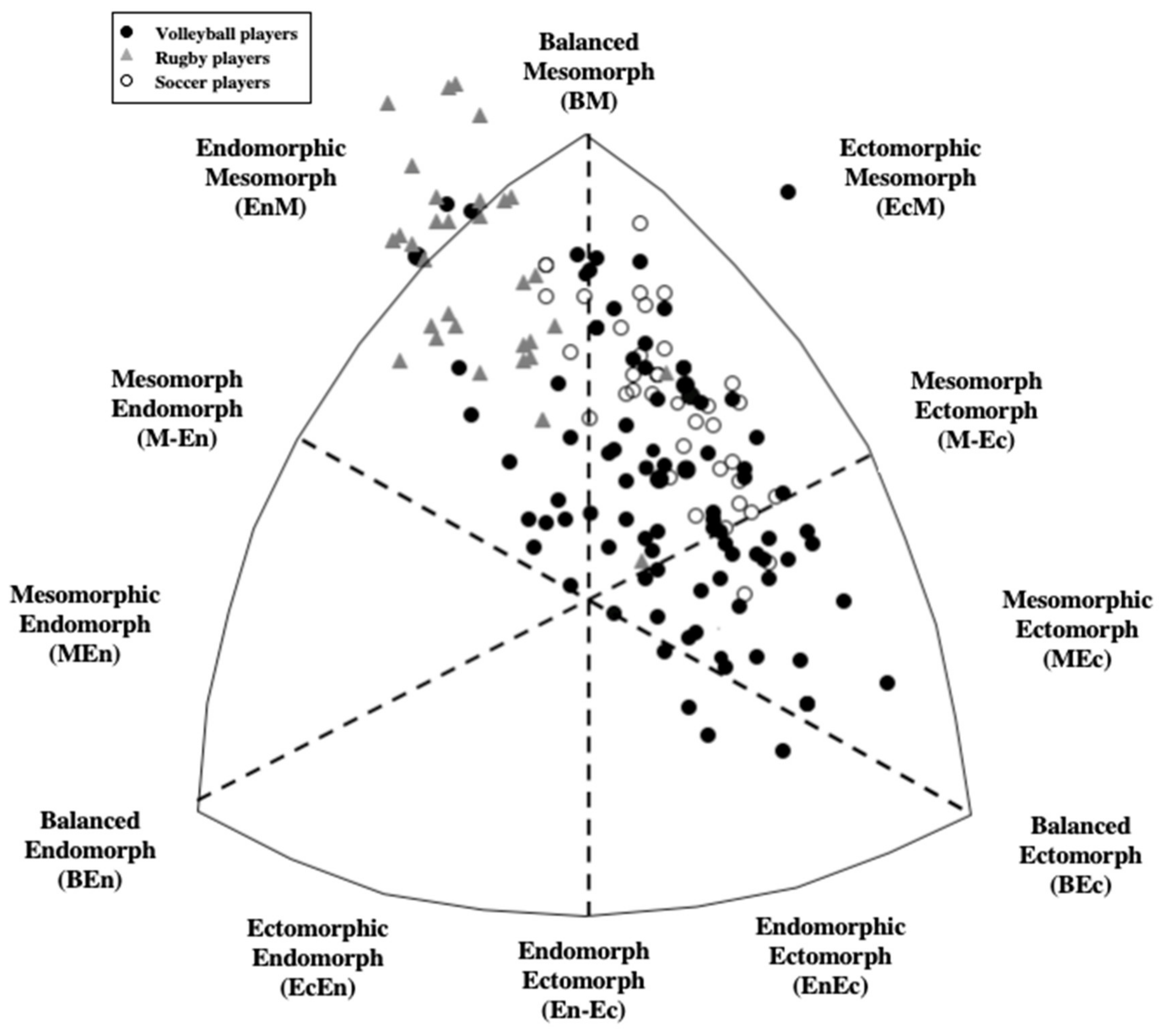
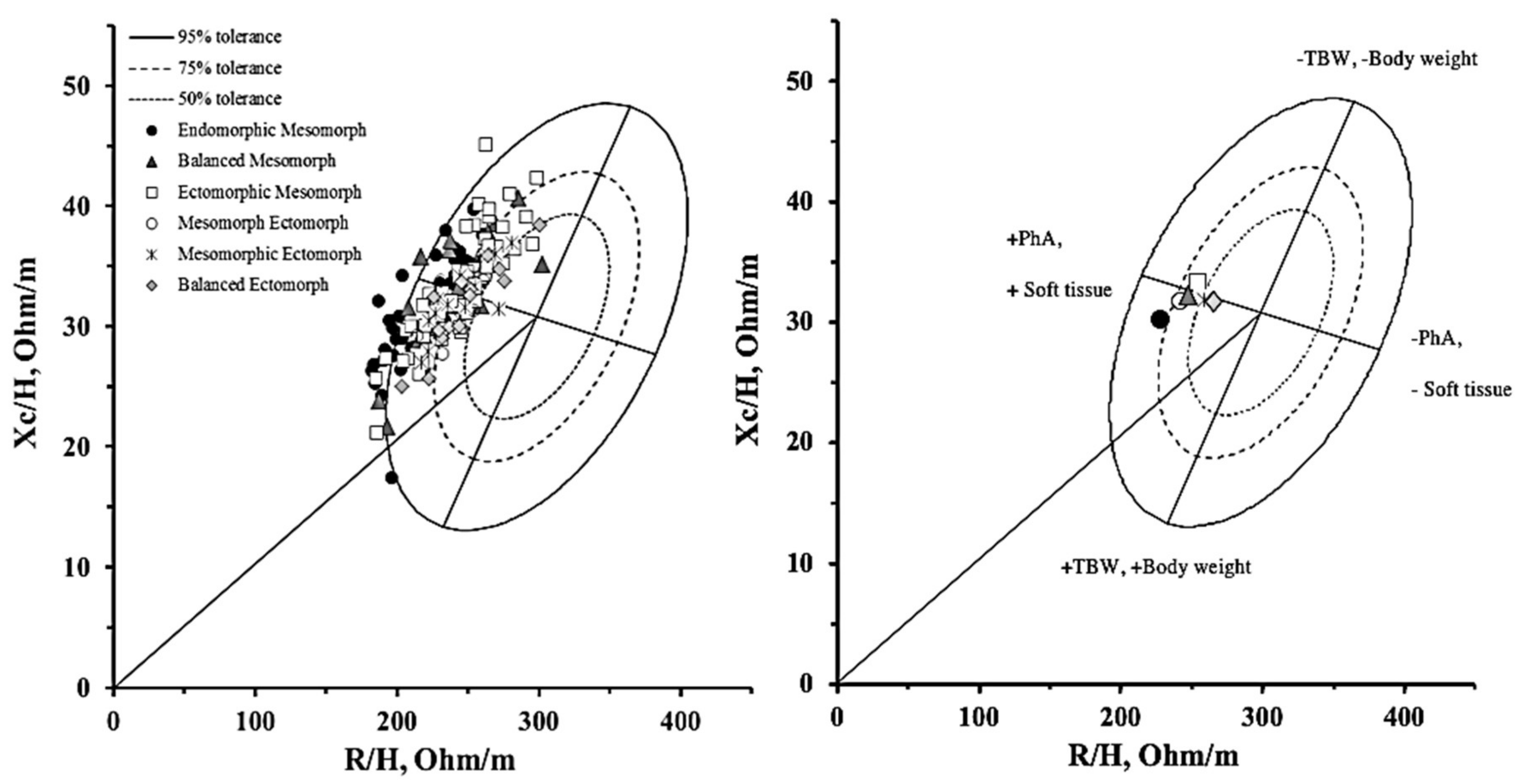
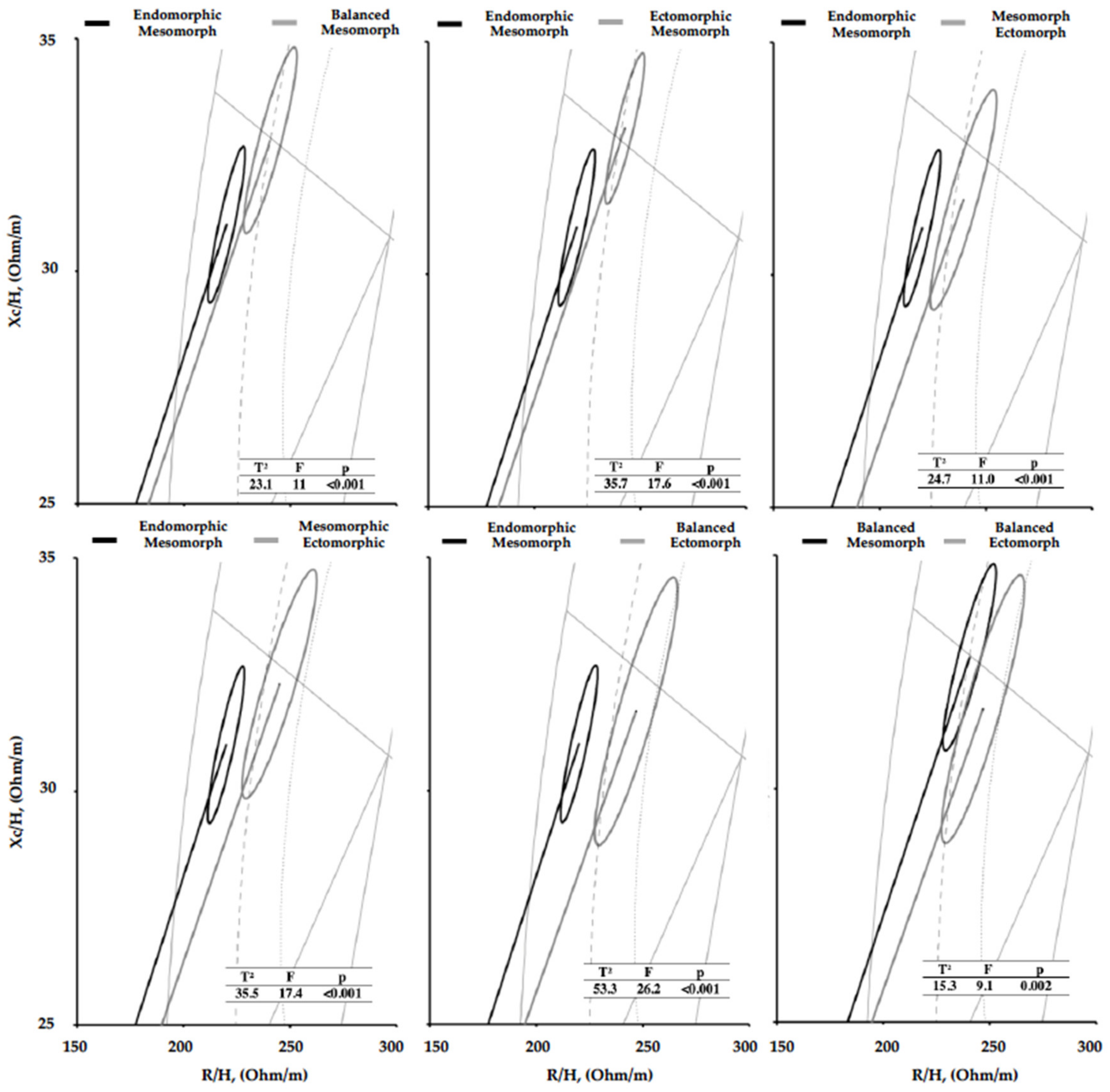
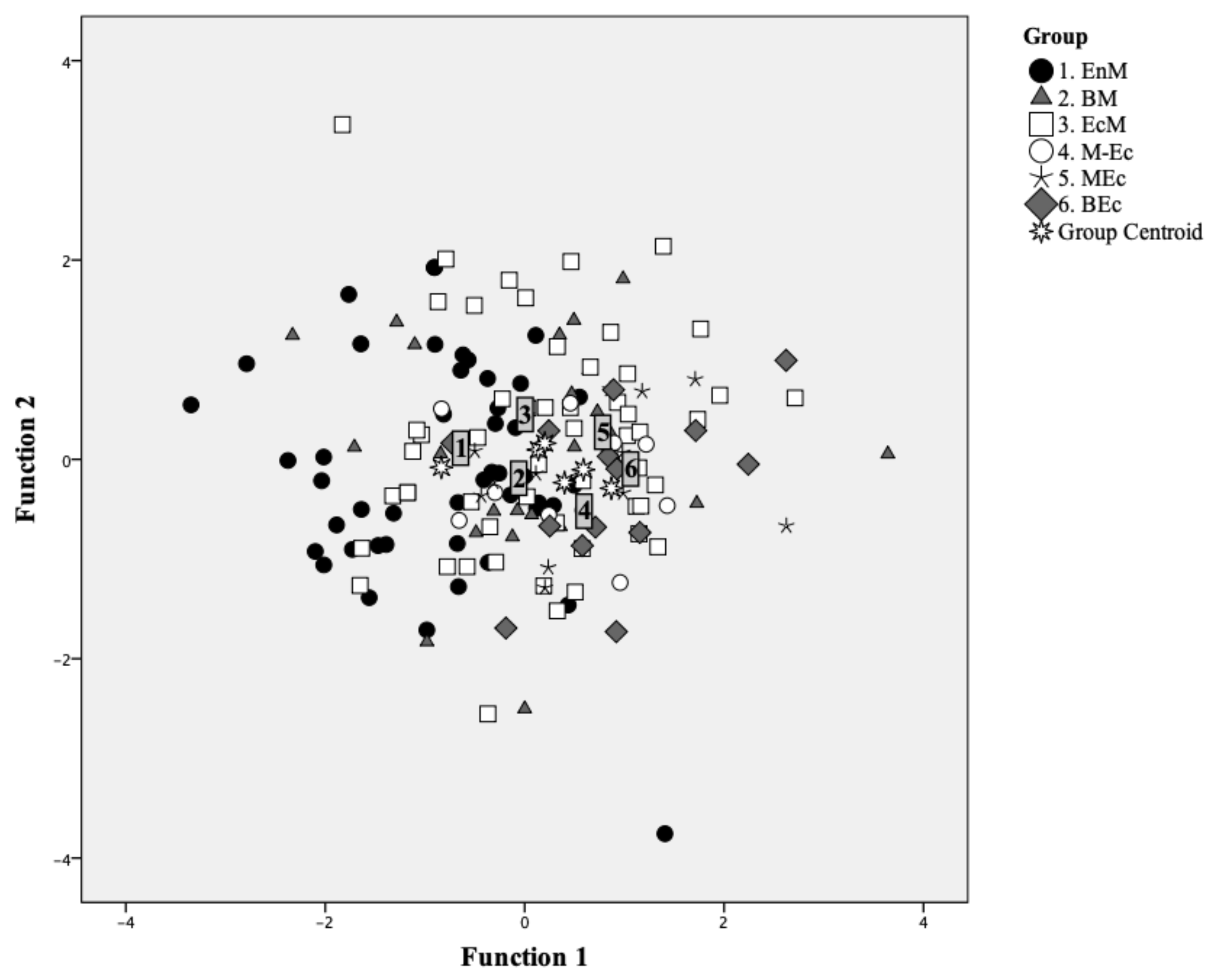
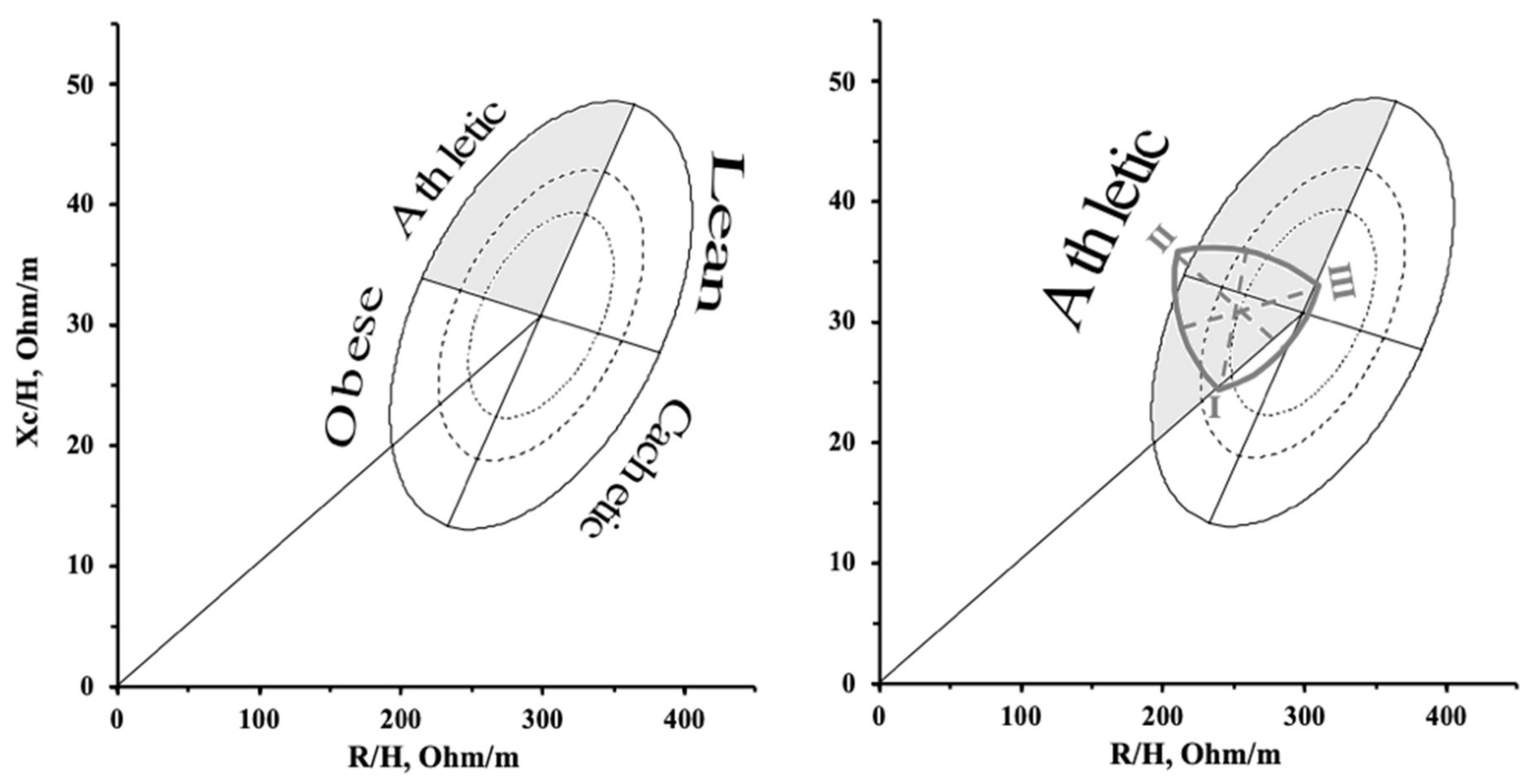
| Variable | Soccer (n = 41) | Volleyball (n = 88) | Rugby (n = 35) |
|---|---|---|---|
| Age (years) | 26.3 ± 3.2 | 26.5 ± 5.6 | 25.9 ± 4.3 |
| Height (m) | 180.6 ± 7.0 | 194.1 ± 10.1 | 184.2 ± 8.4 |
| Weight (kg) | 74.7 ± 8.8 | 89.5 ± 10.4 | 100.7 ± 15.7 |
| BMI (kg/m2) | 22.8 ± 1.7 | 23.8 ± 1.9 | 29.6 ± 3.5 |
| FM (%) | 11.8 ± 2.6 | 13.5 ± 2.1 | 15.5 ± 4.3 |
| FM (kg) | 8.9 ± 2.6 | 12.2 ± 2.8 | 16.1 ± 6.3 |
| FFM (kg) | 65.7 ± 7.0 | 77.3 ± 8.6 | 84.6 ± 10.6 |
| TBW (l) | 54.1 ± 3.4 | 59.8 ± 4.0 | 64.2 ± 6.1 |
| ECW (l) | 12.1 ± 1.1 | 14.1 ± 1.3 | 15.3 ± 2.1 |
| ICW (l) | 42.0 ± 2.3 | 45.7 ± 2.7 | 48.9 ± 4.1 |
| UMA (cm2) | 59.1 ± 10.3 | 70.8 ± 14.7 | 83.7 ± 14.1 |
| UFA (cm2) | 8.6 ± 2.4 | 9.9 ± 3.3 | 12.9 ± 3.7 |
| CMA (cm2) | 104.7 ± 16.7 | 104.9 ± 14.9 | 122.1 ± 40.1 |
| CFA (cm2) | 9.8 ± 2.3 | 12.1 ± 4.3 | 14.7 ± 5.5 |
| TMA (cm2) | 200.2 ± 29.2 | 222.8 ± 37.5 | 260.1 ± 57.1 |
| TFA (cm2) | 22.7 ± 8.2 | 28.9 ± 13.4 | 32.3 ± 11.0 |
| R/H (Ohm/m) | 255.6 ± 21.3 | 236.4 ± 23.4 | 213.6 ± 21.8 |
| Xc/H (Ohm/m) | 35.3 ± 3.8 | 31.8 ± 3.9 | 30.2 ± 4.2 |
| Z/H (Ohm/m) | 258.1 ± 21.5 | 238.5 ± 24.7 | 215.7 ± 22.1 |
| PhA (°) | 7.9 ± 0.5 | 7.7 ± 0.6 | 8.0 ± 0.8 |
| Endomorphy | 1.6 ± 0.3 | 2.0 ± 0.7 | 2.1 ± 0.7 |
| Mesomorphy | 4.7 ± 0.9 | 4.0 ± 1.3 | 6.0 ± 1.1 |
| Ectomorphy | 2.9 ± 0.8 | 3.2 ± 1.1 | 0.9 ± 0.3 |
| Variable | Endomorphic Mesomorph (n = 46) | Balanced Mesomorph (n = 26) | Ectomorphic Mesomorph (n = 55) | Mesomorph Ectomorph (n = 10) | Mesomorphic Ectomorph (n = 13) | Balanced Ectomorph (n = 14) | ANOVA p | |
|---|---|---|---|---|---|---|---|---|
| Height (m) | 183.6 ± 8.7 4,5,6 | 186.7 ± 12.3 5 | 186.7 ± 9.4 4,5 | 199.9 ± 3.4 1,3 | 201.1 ± 5.3 1,2,3 | 195.9 ± 9.4 1 | 12.7 | <0.01 |
| Weight (kg) | 96.6 ± 15.6 3 | 85.0 ± 14.2 | 81.2 ± 13.1 1 | 92.2 ± 6.4 | 90.9 ± 5.8 | 88.1 ± 10.6 | 7.3 | <0.01 |
| BMI (kg/m2) | 28.6 ± 3.7 2,3,4,5,6 | 24.2 ± 1.8 1 | 23.1 ± 1.7 1 | 23 ± 1 1 | 22.4 ± 1.11 | 22.9 ± 1.61 | 32.8 | <0.01 |
| FM (%) | 15.1 ± 3.9 3 | 13.2 ± 1.8 | 11.8 ± 2.2 1 | 14.2 ± 2.4 | 14.2 ± 1.9 | 13.9 ± 2.6 | 7.1 | <0.01 |
| FM (kg) | 15 ± 5.9 2 | 11.3 ± 2.9 | 9.7 ± 2.9 1 | 13.1 ± 3 | 12.9 ± 1.8 | 12.4 ± 3.2 | 9.1 | <0.01 |
| FFM (kg) | 81.5 ± 10.8 3 | 73.6 ± 11.6 | 71.4 ± 10.8 1 | 79 ± 4.4 | 78 ± 5.5 | 75.7 ± 8.5 | 5.4 | <0.01 |
| TBW (l) | 62.5 ± 6 3 | 58.1 ± 5.4 | 56.6 ± 5 1 | 60.8 ± 2.4 | 60.3 ± 2.2 | 59.3 ± 4 | 7.3 | <0.01 |
| ECW (l) | 14.7 ± 1.9 3 | 13.3 ± 1.8 | 12.8 ± 1.6 1 | 14.2 ± 0.81 | 14.1 ± 0.74 | 13.7 ± 1.3 | 7.3 | <0.01 |
| ICW (l) | 47.8 ± 4.0 3 | 44.8 ± 3.6 | 43.8 ± 3.3 1 | 46.6 ± 1.6 | 46.2 ± 1.5 | 45.6 ± 2.7 | 7.3 | <0.01 |
| UMA (cm2) | 80.0 ± 14.4 3 | 68.2 ± 12.5 | 66.0 ± 14.7 1 | 67.1 ± 8.4 | 70.9 ± 12.8 | 64.1 ± 10.5 | 6.5 | <0.01 |
| UFA (cm2) | 12.5 ± 3.5 3,5 | 11.1 ± 3.1 3, | 8.1 ± 2.3 1,2 | 10.1 ± 4.4 | 8.6 ± 2.4 1 | 10.8 ± 3.3 | 11.1 | <0.01 |
| CMA (cm2) | 117.7 ± 36.1 | 103.3 ± 13.6 | 108.8 ± 17.4 | 101.0 ± 16.0 | 99.5 ± 13.6 | 99.9 ± 12.5 | 2.6 | 0.02 |
| CFA (cm2) | 14.1 ± 5.7 3 | 12.5 ± 3.9 | 10.1 ± 2.9 1 | 11.6 ± 3.6 | 11.6 ± 3.7 | 12.9 ± 3.9 | 4.7 | <0.01 |
| TMA (cm2) | 255.9 ± 61.4 3,6 | 220.65 ± 25.1 | 212.8 ± 33.7 1 | 212.3 ± 16.7 | 210.0 ± 26.8 | 203.3 ± 32.2 1 | 7.3 | <0.01 |
| TFA (cm2) | 34.9 ± 16.0 3 | 31.1 ± 12.7 | 22.7 ± 8.7 1 | 29.8 ± 10.2 | 23.4 ± 10.9 | 26.5 ± 9.2 | 4.9 | <0.01 |
| R/H (Ohm/m) | 220.0 ± 23.1 3 | 240.4 ± 26.9 | 242.7 ± 27.1 1 | 239.3 ± 15.5 | 245.0 ± 21.4 | 246.7 ± 25.0 | 5.6 | <0.01 |
| Xc/H (Ohm/m) | 31.3 ± 4.4 | 32.8 ± 4.3 | 33.1 ± 4.7 | 31.6 ± 2.3 | 32.3 ± 2.9 | 31.7 ± 3.7 | 1.1 | 0.39 |
| Z/H (Ohm/m) | 222.3 ± 23.3 3 | 242.7 ± 27.1 | 245.1 ± 27.4 1 | 241.5 ± 15.6 | 247.2 ± 21.6 | 248.8 ± 25.3 | 5.5 | <0.01 |
| PhA (°) | 8.1 ± 0.74 6 | 7.7 ± 0.65 | 7.7 ± 0.58 | 7.5 ± 0.43 | 7.5 ± 0.40 | 7.3 ± 0.39 1 | 4.8 | <0.01 |
| Endomorphy | 2.8 ± 0.59 2,3,4,5,6 | 2.3 ± 0.50 1,3,5 | 1.5 ± 0.28 1,2,6 | 1.8 ± 0.64 1 | 1.4 ± 0.41 1,2,6 | 2.1 ± 0.44 1,3,5 | 43.8 | <0.01 |
| Mesomorphy | 5.9 ± 1.1 2,3,4,5,6 | 4.5 ± 1.1 1,5,6 | 4.6 ± 0.82 1,5,6 | 3.6 ± 0.43 1 | 3.1 ± 0.39 1,2,3 | 2.2 ± 0.54 1,2,3 | 47.7 | <0.01 |
| Ectomorphy | 0.9 ± 0.3 2,3,4,5,6 | 2.3 ± 0.51 1,3,4,5,6 | 3.1 ± 0.57 1,2,5,6 | 3.6 ± 0.27 1,2 | 4.4 ± 0.67 1,2,3 | 4.2 ± 0.56 1,2,3 | 132.0 | <0.01 |
- Differences (p < 0.003) compared with the Endomorphic Mesomorph group;
- Differences (p < 0.003) compared with the Balanced Mesomorph group;
- Differences (p < 0.003) compared with the Ectomorphic Mesomorph group;
- Differences (p < 0.003) compared with the Mesomorph Ectomorph group;
- Differences (p < 0.003) compared with the Mesomorphic Ectomorph group;
- Differences (p < 0.003) compared with the Balanced Ectomorph group.
| Step | Entred | Wilks’ Lambda | F | p |
|---|---|---|---|---|
| 1 | R/H (Ohm/m) | 0.849 | 5.63 | <0.001 |
| 2 | Xc/H (Ohm/m) | 0.736 | 5.19 | <0.001 |
© 2020 by the authors. Licensee MDPI, Basel, Switzerland. This article is an open access article distributed under the terms and conditions of the Creative Commons Attribution (CC BY) license (http://creativecommons.org/licenses/by/4.0/).
Share and Cite
Campa, F.; Silva, A.M.; Talluri, J.; Matias, C.N.; Badicu, G.; Toselli, S. Somatotype and Bioimpedance Vector Analysis: A New Target Zone for Male Athletes. Sustainability 2020, 12, 4365. https://doi.org/10.3390/su12114365
Campa F, Silva AM, Talluri J, Matias CN, Badicu G, Toselli S. Somatotype and Bioimpedance Vector Analysis: A New Target Zone for Male Athletes. Sustainability. 2020; 12(11):4365. https://doi.org/10.3390/su12114365
Chicago/Turabian StyleCampa, Francesco, Analiza M. Silva, Jacopo Talluri, Catarina N. Matias, Georgian Badicu, and Stefania Toselli. 2020. "Somatotype and Bioimpedance Vector Analysis: A New Target Zone for Male Athletes" Sustainability 12, no. 11: 4365. https://doi.org/10.3390/su12114365
APA StyleCampa, F., Silva, A. M., Talluri, J., Matias, C. N., Badicu, G., & Toselli, S. (2020). Somatotype and Bioimpedance Vector Analysis: A New Target Zone for Male Athletes. Sustainability, 12(11), 4365. https://doi.org/10.3390/su12114365









